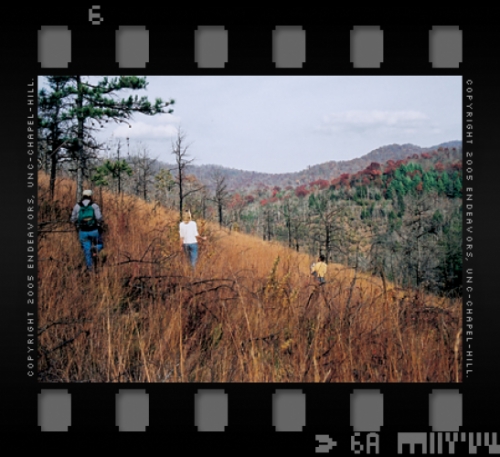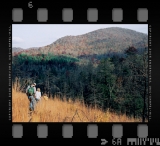Lots of little girls are named after flowers. But three-year-old Rhiannon Weakley has one named after her.
It happened like this: Way back in the late 1970s and early 1980s, Laura Mansberg was a grad student in botany at N.C. State. For her thesis, Mansberg was trying to collect and identify every plant at western North Carolina’s Buck Creek Serpentine Barren. The rocks in a serpentine barren are laced with the mineral serpentine, and as they weather, they produce a thin soil that contains very little calcium but lots of magnesium. (Most plants want just the opposite.) This wild and spiteful soil discourages almost everything except scrubby trees, grasses, wildflowers, and botanists.
Back to Mansberg. She found that she couldn’t identify one particular plant that was growing at Buck Creek: It was some kind of aster, a perennial herb with showy, star-shaped flowers. But it wasn’t in any of her guidebooks or manuals. So she took some specimens and mailed them off to several aster experts.
The experts kept Mansberg’s specimens for a while. They looked at them. They thought about them.
Eventually, all the experts decided that they didn’t know what the plant was either. It might be a new species, they said, or it might be a hybrid between two existing species.
And that was that. Mansberg’s aster languished. Until, that is, little Rhiannon Weakley had a meltdown.
Anyone who’s ever tried to naturalize a toddler knows that there are two things you skip at your own risk: snack time and nap time. Rhiannon’s parents, Allison and Alan Weakley, had taken her to the Buck Creek site one day in 2003, when Rhiannon was one and a half years old. The Weakleys are botanists — Alan is the curator of the University of North Carolina Herbarium — and they had gone to Buck Creek with their botanist friend Tom Govus and his wife.
“Rhiannon hadn’t had a nap that morning,” says Alan Weakley, “and she had a little, ah, loss of composure.”
So the group plopped down to give Rhiannon a snack and a chance to rest. And there, growing all around, was Mansberg’s mystery aster.
“What is this aster?” Govus asked Weakley. “I’ve never been able to figure it out.”
“Well, it’s that odd one that Laura Mansberg collected years ago,” Weakley said. “Nobody’s been able to figure it out.”
“Well, we really ought to figure it out.”
Weakley allowed that Govus was right. After all, the Herbarium is in the business of discovering and identifying North Carolina’s plants. If they didn’t identify the aster, who would?
The group sent specimens to some aster experts that weren’t active in the field back when Mansberg sent her specimens out — botanists such as Guy Nesom of the Botanical Research Institute of Texas and Gary Kauffman of the U.S.D.A. Forest Service. Nesom made careful measurements of the aster and looked at some of its microscopic characteristics. The more he looked, the more he became convinced that the aster was a new species. The rest of the group, including Kauffman, Govus, Weakley, and Mansberg — who is now Laura Cotterman, the publications coordinator at the North Carolina Botanical Garden — eventually agreed. They named the new plant in the journal Sida, Contributions to Botany (December 2004).
Symphyotrichum rhiannon looks — to my bush-league eyes, at least — like it has daisy-sized flowers with purple petals and bright-yellow centers. But here’s the professional, botanical dirt: “What appears to be one flower,” says Cotterman, “is actually a cluster or ‘head’ of tiny flowers, of which there are two kinds: bluish-purple ray flowers and yellow disc flowers.”
“This would be an attractive plant to cultivate,” Weakley adds. “Many of the species closely related to this one are sometimes grown as woodland garden plants. So it is something that has some horticultural potential.”
It’s also possible — though not proven — that Rhiannon’s aster grows only in the Buck Creek Serpentine Barren. There’s a smattering of other serpentine barrens in southwestern North Carolina and north Georgia, and botanists haven’t really scoured those barrens for Rhiannon’s aster. “But here at the Herbarium we have hundreds of specimens of the things that this aster is most closely related to,” Weakley says. “And you can shuffle through all those specimens and see that none of them are this plant. So if this plant were common, we’d have other specimens of it from other places, simply by chance.”
So what does Rhiannon think about all this? Her dad laughs. “She really likes plants, and likes to be out in the garden,” he says. “But I don’t think she identifies with the fact that it’s named after her. In a few years, I’m sure she’ll think it’s pretty cool.”






